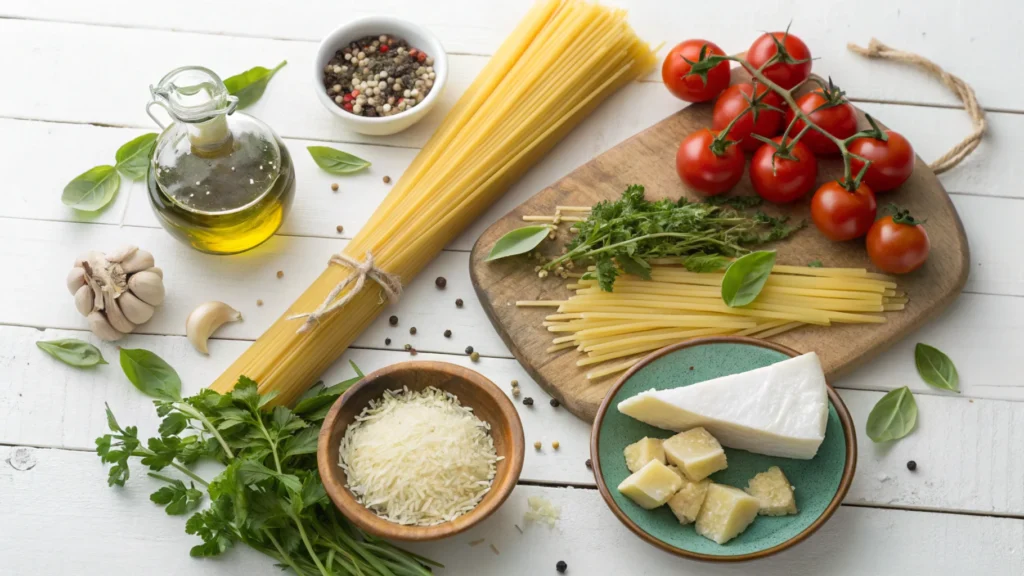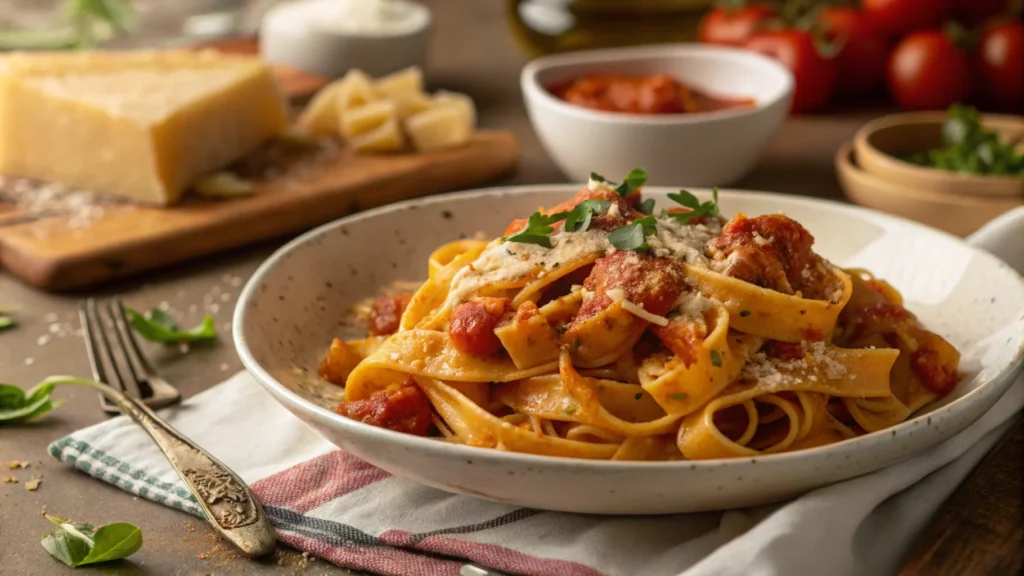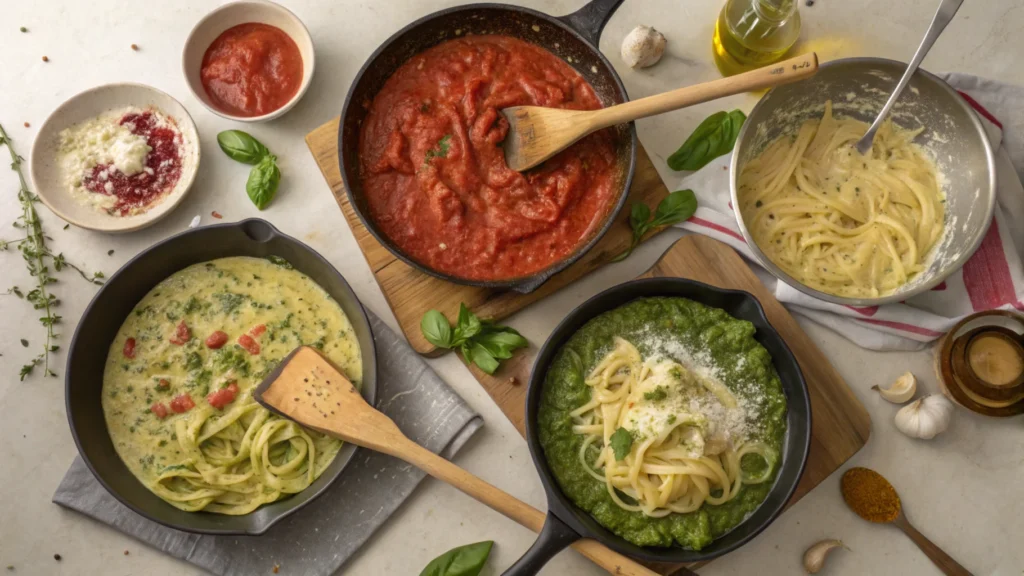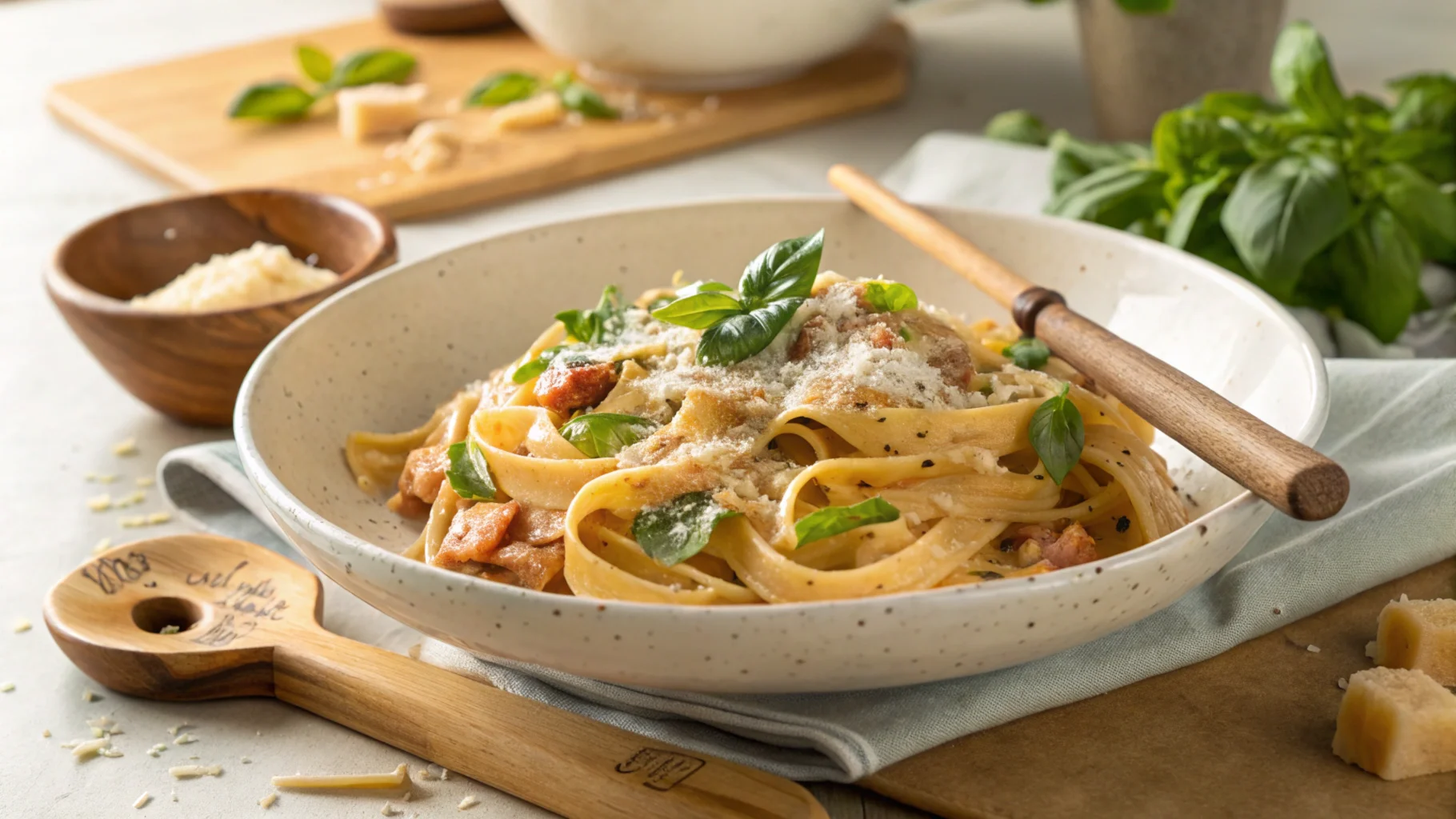Pasta recipes are a beloved dish worldwide, known for their versatility and ease of preparation. Whether you prefer creamy sauces, vibrant and zesty flavors, or hearty combinations, you can tailor pasta to suit any occasion and taste.
To create perfect pasta dishes, it’s essential to understand the key ingredients and proper cooking techniques. For instance, selecting the right pasta type plays a crucial role. Moreover, balancing flavors and textures ensures delicious results every time. Additionally, you can explore classic recipes or experiment with creative global variations, depending on your style.
For a wholesome meal, consider pairing your pasta with flavorful Chicken Thigh Recipes. These protein-packed options complement pasta beautifully, adding depth and richness to your dishes. Start your pasta journey today and elevate your culinary skills!
Essential Ingredients for Perfect Pasta
To make the best pasta, you need to start with the right ingredients. A few key elements can elevate a simple pasta recipe, helping you create a dish that’s both flavorful and satisfying Here are the essential ingredients you’ll need:
- High-Quality Pasta: Whether you buy dried or fresh, using high-quality pasta is crucial. The pasta should have a good texture and be firm enough to hold up during cooking.
- Fresh Herbs: Fresh basil, parsley, or oregano will infuse your pasta recipes with vibrant flavors that dried herbs can’t replicate.
- Olive Oil: This is the foundation of many pasta dishes. A good quality extra virgin olive oil adds richness and depth to sauces.
- Garlic: A key ingredient for creating aromatic bases for many pasta sauces, garlic enhances the overall flavor profile of your dish.
- Tomatoes: Fresh or canned, tomatoes are central to many pasta sauces, contributing acidity, sweetness, and body to the dish.
- Cheese: Cheeses like Parmesan, pecorino, or ricotta commonly enrich pasta recipes, adding richness and creaminess.
- Seasonings: Salt and freshly ground black pepper are essential to elevate the flavors of your pasta.
Once you gather these basic ingredients, you’ll be ready to create a variety of pasta recipes. Keep in mind that the quality of ingredients directly affects the final taste, so always choose the best you can find.

Types of Pasta: A Comprehensive Guide
There are many types of pasta, and each one serves a unique purpose in various pasta recipes. Some pasta types work better with rich, hearty sauces, while others pair perfectly with lighter, simpler combinations. Below is a comprehensive guide to some of the most popular pasta types and their uses:
- Spaghetti: One of the most iconic pasta types, spaghetti works well with almost any sauce, from marinara to carbonara.
- Fettuccine: This wide, flat pasta is perfect for creamy sauces like Alfredo.
- Penne: Short and tubular, penne is excellent for catching chunky sauces such as meatballs or arrabbiata.
- Linguine: Chefs typically use linguine, which is flatter than spaghetti, with seafood-based sauces.
- Rigatoni: With large ridges, rigatoni is perfect for holding onto thick, meaty sauces.
- Macaroni: Ideal for macaroni and cheese, or served in a creamy sauce.
Each pasta shape has its characteristics, and understanding these can help you choose the right one for your pasta recipes. Keep in mind that fresh pasta often pairs better with delicate sauces, while dried pasta holds up well with heavier, more substantial ones.
Making Homemade Pasta from Scratch
Making homemade pasta can be a rewarding experience, offering you control over the ingredients and texture. While it might seem daunting at first, the process is simpler than you might think. Here’s how you can create fresh pasta from scratch:
Ingredients:
- 2 cups of all-purpose flour
- 2 large eggs
- 1 tablespoon olive oil
- A pinch of salt
Instructions:
- Mix the Ingredients: Start by creating a mound with the flour on your countertop. Make a well in the center and add eggs, olive oil, and salt.
- Combine and Knead: Slowly combine the flour with the eggs and knead the dough until it becomes smooth and elastic. This can take around 10 minutes.
- Roll the Dough: Use a rolling pin to roll the dough into thin sheets. If you have a pasta machine, you can use it to achieve an even thickness.
- Cut the Pasta: Cut the dough into your desired pasta shape, whether it’s fettuccine, tagliatelle, or ravioli.
- Cook: Fresh pasta cooks much faster than dried pasta, typically within 2-4 minutes.
Making fresh pasta can elevate your dishes and add a personal touch to your meals. Moreover, the process allows you to experiment with flavors and textures, ultimately creating unique pasta recipes that suit your preferences.
Classic Pasta Recipes for Beginners
For beginners, starting with some classic pasta recipes is a great way to learn the basics and build confidence in the kitchen. Furthermore, these dishes are simple to make and provide a solid foundation. Below are a few staple pasta dishes that are both easy to prepare and perfect for newcomers:
- Spaghetti Aglio e Olio: This simple dish requires just a few ingredients—spaghetti, garlic, olive oil, chili flakes, and parsley. It’s quick, flavorful, and perfect for a weeknight meal.
- Penne Arrabbiata: A spicy tomato sauce with garlic, chili flakes, and olive oil makes penne arrabbiata a flavorful and satisfying dish.
- Mac and Cheese: A classic comfort food, mac and cheese combines elbow macaroni with a creamy cheese sauce. Furthermore, you can add breadcrumbs for a crispy topping.
- Carbonara: This creamy pasta dish is made with eggs, cheese, pancetta, and black pepper, creating a rich and comforting meal.
These pasta recipes are easy to master and require only a few basic ingredients. As a beginner, focusing on simple dishes allows you to build your skills before moving on to more complex pasta creations.

Regional Italian Pasta Dishes
Italy boasts an incredible variety of pasta recipes, each influenced by regional ingredients and traditions. In fact, from north to south, different areas of Italy have their own signature pasta dishes. Consequently, here are some regional pasta recipes to try:
- Pasta alla Bolognese (Emilia-Romagna): This rich, meaty sauce is traditionally served with tagliatelle. It’s a classic ragù made with ground beef, pork, and tomatoes, simmered to perfection.
- Pesto alla Genovese (Liguria): Pesto is a vibrant, herb-based sauce made from basil, garlic, pine nuts, Parmesan, and olive oil. Additionally, it’s typically paired with trofie pasta in Genoa.
- Cacio e Pepe (Lazio): This Roman dish is a simple combination of pecorino cheese and black pepper, creating a creamy sauce that coats spaghetti or tonnarelli.
- Orecchiette con Cime di Rapa (Puglia): A traditional dish from Puglia, it features orecchiette pasta with a bitter-sweet sauce made from turnip greens, garlic, and anchovies.
These regional pasta recipes offer a glimpse into Italy’s diverse culinary culture. Moreover, by trying them, you can gain a deeper appreciation for how various ingredients and flavors shape pasta dishes across the country.
Global Variations of Pasta Recipes
While Italy is the birthplace of pasta, the love for pasta recipes has spread worldwide. Different cultures have embraced pasta and adapted it to their own culinary traditions. Here are some global variations:
- American Mac and Cheese: This beloved dish has become a comfort food staple in the U.S. The creamy, cheesy sauce is made with cheddar and often includes a crunchy breadcrumb topping.
- Japanese Pasta (Wafu Pasta): Wafu pasta incorporates Japanese ingredients like soy sauce, miso, and fish-based broths, offering a fusion of Italian and Japanese culinary traditions.
- Chinese Noodles: While not exactly pasta, Chinese noodles share similar characteristics. They are used in stir-fries, soups, and cold dishes, often paired with soy sauce, sesame oil, and vegetables.
- Latin American Pasta: In countries like Mexico and Argentina, pasta is often incorporated into stews and served with salsas made from tomatoes, peppers, and spices.
Exploring these international variations not only allows you to discover unique flavor profiles but also broadens your understanding of how pasta recipes can be adapted around the world.

Vegetarian and Vegan Pasta Recipes
Pasta recipes are naturally versatile and can be easily adapted for vegetarian or vegan diets. Additionally, by focusing on plant-based ingredients, you can create delicious and hearty pasta dishes. To inspire you, here are some ideas:
- Vegan Bolognese: Swap ground meat for lentils or mushrooms to create a plant-based version of the classic Bolognese sauce.
- Pasta Primavera: A colorful dish filled with fresh, sautéed vegetables like zucchini, tomatoes, and bell peppers, tossed in olive oil and garlic.
- Vegan Alfredo: Use cashews or cauliflower to create a creamy vegan Alfredo sauce that rivals its dairy counterpart.
- Pesto with Cashews: For a dairy-free twist, replace Parmesan cheese with cashews in your pesto sauce.
These vegan and vegetarian pasta recipes are just as flavorful and satisfying as their meat-based counterparts. They also offer a great way to enjoy pasta while adhering to plant-based diets.
Gluten-Free Pasta Options
If you’re following a gluten-free diet, there are plenty of pasta options available. Many brands now offer gluten-free pasta made from ingredients like rice flour, corn, or quinoa. Here are some tips for cooking gluten-free pasta:
- Cook Time: Gluten-free pasta tends to cook faster than regular pasta, so be sure to follow the package instructions.
- Rinse after Cooking: To prevent the pasta from becoming sticky, rinse it under cold water once it’s done.
- Sauce Pairings: Lighter sauces like pesto or olive oil-based dressings work well with gluten-free pasta, as they won’t weigh down the dish.
By choosing high-quality gluten-free pasta, you can create delicious dishes that don’t compromise on taste or texture. Furthermore, this option allows you to enjoy pasta without sacrificing flavor.
Sauces That Elevate Your Pasta
A great pasta dish is only as good as the sauce that accompanies it. Moreover, the right sauce can elevate your pasta recipes to the next level. Below are some sauces that can truly transform your dish:
- Marinara: This classic tomato-based sauce is flavored with garlic, onions, and herbs. It pairs well with spaghetti, penne, or rigatoni.
- Alfredo: It is a rich, creamy sauce made from butter, cream, and Parmesan, making it perfect for fettuccine or other wide pasta.
- Pesto: This fresh, herbaceous sauce is made from basil, garlic, pine nuts, and olive oil. It’s great with linguine, spaghetti, or gnocchi.
- Carbonara: A creamy, egg-based sauce with pancetta, pecorino cheese, and black pepper. It’s ideal for spaghetti or fettuccine.
Experimenting with different sauces is key to mastering pasta recipes. In addition, by pairing the right sauce with the right pasta, you can create the perfect dish for any occasion.
Tips for Cooking Pasta Perfectly
Cooking pasta seems simple, but there are a few tips to ensure you achieve the best results every time:
- Use Plenty of Water: For optimal texture, use 4-6 quarts of water per pound of pasta.
- Add Salt: Salt the water generously to enhance the pasta’s flavor.
- Stir Frequently: Stir the pasta occasionally to prevent it from sticking together.
- Taste for Doneness: Start testing the pasta a minute or two before the suggested cooking time is up.
These simple yet effective tips will help you cook pasta to perfection, ensuring that your pasta recipes turn out exactly as you desire.
FAQs: Common Questions About Pasta Recipes
What is the most popular pasta dish?
Spaghetti Bolognese is undoubtedly one of the most popular pasta dishes. It features a rich meat sauce made with ground beef or pork, which is then served with spaghetti.
Why is it called “marry me pasta”?
“Marry Me Pasta” gets its name from its deliciously irresistible flavor, with a creamy garlic and sun-dried tomato sauce so good it’s said to inspire a marriage proposal.
How to cook pasta step by step?
- Boil Water: Bring a large pot of salted water to a boil.
- Add Pasta: Stir in the pasta and cook according to package instructions.
- Taste & Drain: Taste for doneness, then drain the pasta.
What are the 4 main Italian pasta dishes?
- Spaghetti Carbonara: A creamy pasta with eggs, cheese, and pancetta.
- Lasagna: Layered pasta with meat sauce, béchamel, and cheese.
- Penne Arrabbiata: Spicy pasta with garlic, chili, and tomato sauce.
- Pesto alla Genovese: Fresh basil pesto with garlic, pine nuts, and olive oil.
Conclusion: Mastering Pasta Recipes for Every Occasion
Pasta recipes are diverse, comforting, and loved worldwide. They offer endless possibilities, from creamy traditional Italian dishes to light vegan options, catering to every palate and occasion. By mastering essential ingredients, classic techniques, and global variations, you can create pasta meals that are both flavorful and satisfying.
To elevate your pasta experience, consider complementing it with other dishes. For a perfect pairing, explore the rich and savory options in the guide to Flat Iron Steak: Why It’s More Expensive and Worth It | Tender, Juicy, and Flavorful. The tender and juicy flavors of flat iron steak beautifully balance the richness of pasta, creating a meal that’s truly unforgettable.
Next time you’re in the kitchen, let these recipes inspire you to embrace the delicious world of pasta and beyond!

